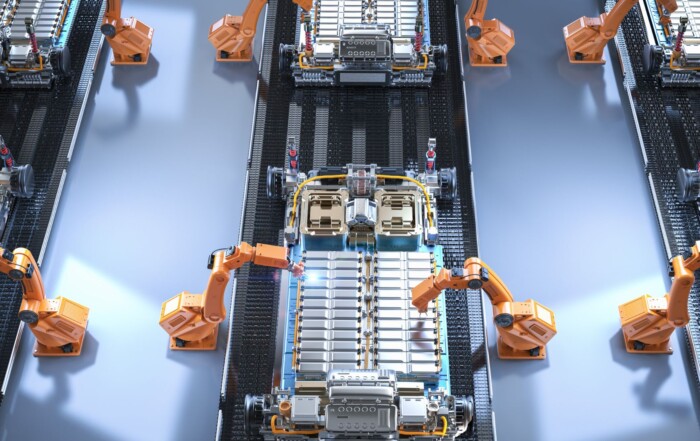Open sesame –
Radar-based motion detection for automatic door opening.
For several decades now, we have enjoyed the benefits of automatically controlled doors. We usually encounter them in public buildings such as department stores, banks, or supermarkets. They provide us with greater convenience and are an important measure to enable barrier-free access. We gain access to the inside or outside through our presence or movement. Contactless and unconscious. Using the sensors is practical and convenient, especially when we don’t have a hand free.
For the building itself, installing automatic doors increases energy efficiency. Doors or gates don’t remain open any longer than necessary and prevent heating bills from skyrocketing. The technological principle is also used for barrier-free access. Sensor-controlled door opening has long been part of our everyday life. But motion sensors have a few challenges to overcome.
Open and closed – with every movement
In order to trigger opening or closing, little sensors are installed that detect movements in their surroundings. The tricky thing is to avoid misinterpreting movements. In addition, the function should be as precise as possible. The automatic system should be triggered when we actually need it – i.e. only react to relevant events. It shouldn’t close or open in the event of movements by animals or passers-by. Such false triggering minimises efficiency for this use case. Also, the door or gate should only be open as long as is actually necessary. In addition, there are the influences of the measurement environment, which can impact performance. For example, components, technical systems, vehicles, or even the weather can affect functionality.
Detection & information processing
The technical challenge lies in filtering the detected information appropriately, suppressing interference factors, and programming the sensor to transmit only certain signals. The properties of the measuring method used lay the foundation for the basic function. The more extensive the data provided by each technology, the more efficient the function is.
However, as the development work and functionality increase, so do the costs of the sensor solution. By further developing the current sensor technologies, manufacturers are increasingly able to sell the products at affordable prices, despite advanced functions. Thus, some of the challenges presented by the use case of automatic doors can already be solved today.
PIR and RADAR open any door
Two means of measurement have prevailed on the market so far, thanks to their benefits: passive infrared sensors and radar detection. Both technologies are suitable for automatic door opening. However, they differ significantly in terms of their functional capabilities and associated performance. Until recently, radar was also thought of as very expensive and was mainly considered for demanding applications. At the same time, PIR was considered the best choice for low-cost, simple door opening. Meanwhile, prices have been increasingly converging. Through radar’s special properties, it boasts a price-performance ratio making the technology attractive even for the low-cost range and rendering the original rules obsolete.
More information means more efficiency
Compared to PIR, radar provides additional object information that contributes to the motion sensor’s functioning. While infrared only receives information about a movement, radar provides additional data when used as a means of positioning. Depending on its modulation, the sensor can determine not only the presence of a moving and/or stationary object, but also its speed, direction of movement, distance, and angular position. Users thus are provided with comprehensive data on the current activity in the detection area which enable the object to be positioned and observed with precision. Analysis and evaluation of the raw data during signal processing allow the radar system’s function to be precisely specified. For example, the sensor uses the directional information to detect whether a person is approaching or moving away from the door. The door might then only open when someone is approaching, for instance.
Reliable when others fail
Another plus point about radar sensors is their robustness. This owes primarily to their operating principle. The sensors utilise electromagnetic waves to detect and locate objects. The waves cannot be influenced by lighting conditions – so the technology can be employed day and night. Radar also boasts a wide operating temperature range. Cold or heat don’t affect the technology. Other environmental influences such as weather, dust, or dirt don’t impact the functionality of radar either. This makes the sensors ideal for outdoor deployment. Other sensor technologies, to the contrary, work with light, heat, or sound waves. This causes problems in the dark or extreme temperatures, or with insulating materials, vibrations, or noise.
Extensive functionality and reliability don’t constitute the essential purchase criterion for every application. Sometimes users are simply looking for a cheap solution and will put up with limitations and inaccuracy. Depending on the complexity of the task, individual considerations must be made as to which of the two sensor technologies is suitable. You can find out more about the advantages of radar equipment and radar in comparison to PIR here.
Application examples
InnoSenT GmbH has been manufacturing extremely small sensors that are successfully being used as door sensors since the company was founded. Over time, the company has launched a range of innovative products. The continuous further development of the technology is also opening new doors in the field of building automation. Customers thus now enjoy a broad selection functions to meet the challenges of their specific application. Four examples illustrate the differences between the door opener portfolios.
If you have any further questions about the InnoSenT product portfolio, feel free to contact our sales team or visit the company website at: www.innosent.de/en/
picture: © MyCreative by adobe stock
Share this Content
Building Automation & Smart Home
Contactless and intelligent control for modern technology
Radar sensors take on many tasks for us, thus making our everyday lives easier, safer, and more efficient. They are a kind of sensory organ for objects for perceiving their surroundings. These technological assistants open up new possibilities for operating devices: contactless interaction between humans and devices. The sensors are the link for triggering or automating certain actions without contact or automating them.


